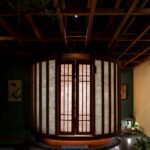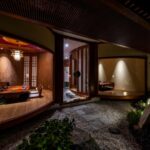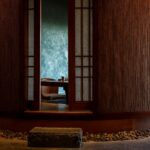Embracing Cultural Fusion
AKAARI, a renowned Japanese cuisine chain in Hanoi, sought a transformative interior redesign melding Vietnamese cultural elements with Japanese aesthetics. Both nations share a profound appreciation for handicrafts, particularly bamboo, rattan, and ceramics. The project aimed to spotlight the vast potential of these materials and infuse them with new vitality.

Integrating Nature and Culture
Prior to renovation, the restaurant occupied two Shophouse apartments nestled in a modern urban area. These structures, characterized by concrete and glass, lacked warmth and character. The design challenge lay in creating a space that harmonized Vietnamese and Japanese cultures while fostering intimacy and comfort. Utilizing the generous floor height of approximately 4.5m, the design incorporated ventilation into common areas. The entrance hall and second-floor dining space boasted wooden roof systems, imbuing warmth and intimacy. Private dining rooms offered a cozy retreat within the larger restaurant, countering the stark exterior.


Crafting Ethereal Spaces
The second-floor ceiling featured a drop cloud system, evoking floating clouds and enhancing the ambiance. Private rooms were elevated as mezzanine floors, separated by expansive rattan walls, preserving the sense of unity with the surrounding garden. On the third floor, a wooden frame ceiling lent depth and spaciousness to the lobby. To mitigate the harsh western sunlight, a buffer garden space adorned the glass facade, cascading from the room to the adjacent park, creating a verdant oasis.

Merging Gardens with Interiors
From the entrance hall to common spaces, the floor was adorned with sanded concrete mixed with gravel, lending an organic touch. The Sushi Bar and Dining room on the second floor were adorned with colorful ceramic tiles from Bat Trang, a famed pottery village in Hanoi. Flexible walkways imbued the space with a garden-like ambience, fostering a sense of relaxation and fluidity. The main staircase, crafted from steel, wood, and rattan, not only served as a decorative element but also facilitated vertical air convection throughout the four-story structure.

Reimagining Craftsmanship
Central to the project was the revitalization of traditional craft villages. Skilled artisans specializing in lamps and handicrafts were enlisted to repurpose architectural components such as doors, partitions, and ceilings. Careful attention was paid to size and proportions, ensuring functionality without compromising the airy, inviting atmosphere.

In essence, Akaari Premium Restaurant stands as a testament to the seamless fusion of tradition and innovation, where cultural heritage intertwines with contemporary design to create a transcendent dining experience.
















